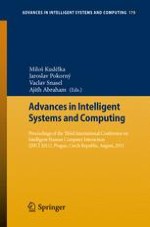The Third International Conference on Intelligent Human Computer Interaction 2011 (IHCI 2011) was held at Charles University, Prague, Czech Republic from August 29 - August 31, 2011. This conference was third in the series, following IHCI 2009 and IHCI 2010 held in January at IIIT Allahabad, India.
Human computer interaction is a fast growing research area and an attractive subject of interest for both academia and industry. There are many interesting and challenging topics that need to be researched and discussed. This book aims to provide excellent opportunities for the dissemination of interesting new research and discussion about presented topics. It can be useful for researchers working on various aspects of human computer interaction. Topics covered in this book include user interface and interaction, theoretical background and applications of HCI and also data mining and knowledge discovery as a support of HCI applications.
